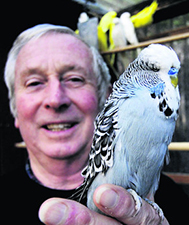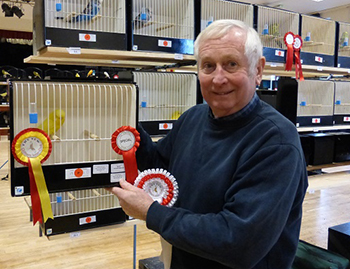
by Roger Carr
Thirty five years ago my father did something that was to
profoundly affect the majority of my life. The something he did
was to erect a small aviary against his garage and buy me three
pairs of budgerigars. Amongst those budgerigars was a Lutino
hen, and it was that bird which set me in pursuit of the Ideal.
In those days Lutinos tended to be all color with narrow heads
and razor sharp beaks, but there again, this was not unusual as
all budgerigars tended to be that way. Many a time I had
visitors who would say "Oh, I see you keep canaries as well as
budgerigars" to which I would answer "No, the yellow birds are
Lutinos, a variety of budgerigars with red eyes".
Since those days the variety has been developed beyond
recognition. The true facts are that birds which won for
Champions in those days would not even feature in the cards for
beginners today. It is often said that color is not as good as
it was. This is true. The Lutinos of earlier days owed their
color to the fact that they were all fine yellow feathered birds
unlike the buff and semi-buff birds of today. Even now it is
possible to produce color of equal or better quality than that
of the past, but the sacrifice that usually has to be made is
the appearance in size. I stress the appearance of size, as the
structure of a yellow feathered bird can be identical to that of
a buff but the normal visual appearance is that the buff is a
bigger bird. It is therefore the quest for the appearance of
size that has led to the deterioration in color. The emphasis
for all varieties is clearly placed on size, shape, deportment
and size and shape of head. With 65% of the total points
allocated to these attributes it was obvious that the 35%
allocated for color would always become secondary.

In all other respects the bird has been greatly improved. Even
the yellow feathered birds are substantially larger with broader
heads and greater depth of face. However the head qualities of
most Lutinos are still well behind their light green
counterparts. Perhaps the reason for this is because the
contrast that exists between the yellow face and body color of
light green is readily noticeable and therefore any improvement
is easily assessed, where as the correspondence lines on a
Lutino are not easily identified although they still exist.
One area in which Lutinos invariably seem deficient is frontal
rise. Here again the way in which the variety has been enlarged
could have a bearing on this attribute. The majority of
outcrossings invariably involve a large Lutino cock to an even
larger, broad headed, Opaline hen. The result is large buff
feathered Lutino hens with broad faces but no frontal rise. When
these birds are paired the first priority is to improve color
and before frontal rise is considered the stud is normally
involved in a further quest for size.
Over the years there have been many well known breeders of
Lutinos, the recipe for success is easy. Once you have size just
add color, width of face and frontal rise. Or is it once you
have color add size, width of face and frontal rise? Or is
it....? Never mind, work it out for yourself. That way you will
get real satisfaction from the little so and so's.
![]() Check
out the articles in our Reference Library
Check
out the articles in our Reference Library
